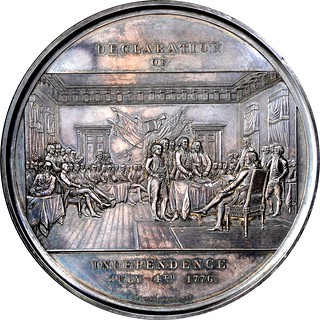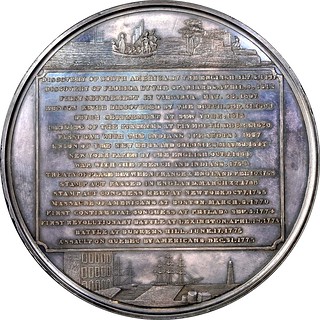
PREV ARTICLE
NEXT ARTICLE
FULL ISSUE
PREV FULL ISSUE
V25 2022 INDEX E-SYLUM ARCHIVE WRIGHT'S DECLARATION OF INDEPENDENCE MEDALSedwick Auctions is offering an important medal by Charles Cushing Wright in their upcoming sale closing November 4, 2022. Here's an excerpt from the lot description. -Editor USA, proof silver medal, Declaration of Independence (struck in the 1850s), by Charles Cushing Wright, unique in silver, NGC MS 62 [sic], ex-Bushnell, ex-Garrett, ex-Adams. Musante GW183; Baker (Rulau-Fuld) 53G. 91mm; 259.0 grams. NGC 6481717-001. Pedigreed to the John Adams Collection, with entire ownership pedigree dating back to Charles Ira Bushnell (Chapman auction of June 1882, lot 1274), Garrett Estate (Bowers & Ruddy auction of April 1981, lot 1910), Julian Leidman (Bowers & Merena auction of April 1986, lot 4126), and Charles A. Warton (Stack's Bowers auction of March 2014, lot 2077), subsequently purchased by Adams in the Stack's Bowers auction of August 2018 (lot 46). Estimate: $25,000-up. Manmade beauty comes in many forms. As numismatists we discern artistic beauty in a handheld piece of history. The beauty of a coin or medal starts with its engraver; next its striking, which is critical as a bad strike can ruin a beautiful design. Finally, the toning of the metal, which takes many years to happen, is a process over which we have much less control. For some pieces, there is one final distinction, a coup de grâce known as pedigree, for only a piece that was held and admired by the greatest collectors can have such psychological beauty.
When this medal was designed and struck sometime in 1852 to 1854 by Charles Cushing Wright, only a bronze version was advertised, first published in Norton's Literary Letter in 1857. The first auction appearance of one of these bronzes (of which only two to four are known today), was in the Edward Cogan (Philadelphia) sale of March 25-26, 1862, from a collection billed as Why did they believe it was unique? The answer lies in the owner, Bushnell, who was a known patron of Wright's work and presumably had it struck for himself as a specimen. It is inconceivable that the Chapmans would have made that assertion if Bushnell himself had not told them. Note it was also described as Proof by the Chapmans, another term that they would only state if true (a fact that was recognized by PCGS when this piece was graded as SP63 by that firm, its current designation of MS 62 by NGC a bit indefensible).
The design itself was not unique, however. Not only were there identical versions in bronze, as noted, but also its scene of the presentation of the draft of the Declaration of Independence to the Continental Congress on June 28, 1776 (based on the famous 1818 painting by John Trumbull that hangs in the rotunda of the U.S. Capitol and graces the back of our $2 bill) was used by Wright to make other medals with the bust of George Washington on the other side. It is interesting to note that even as long ago as 1882 the Chapman Brothers erroneously described this scene as the signing of the Declaration of Independence, whereas in fact the image shows the five-man drafting committee (consisting of John Adams, Richard Sherman, Robert R. Livingston, Thomas Jefferson, and Benjamin Franklin) presenting their draft to a seated John Hancock. Each man pictured in the scene was a real person, 47 in all, of which 42 were actual signers of the Declaration (fourteen signers were not depicted, as Trumbull could not find accurate likenesses of them, the remaining five The other side of the medal bears a square tablet with a veritable curriculum vitae of the United States, listing eighteen events that led up to the momentous occasion of our Independence, as follows:
DISCOVERY OF NORTH AMERICA BY THE ENGLISH.JLY.3.1497
Scenes at top and bottom depict a small boat of Europeans landing at a rocky promontory guarded by an Indian (often described as Columbus' landing in the New World, but that is doubtful considering the list of events) above, and a wharf scene with building, ships and lighthouse at bottom (perhaps Boston Harbor, but the design of the lighthouse is different). As with the other side, the artistry is par excellence. Well designed and well struck, yes… but the third aesthetic factor is the icing on the cake: As a silver medal, this piece was subject to whatever mysterious chemical forces cause colorful toning on silver only, such that in the right light the surfaces positively radiate with a supernova burst of blue, green, purple and golden orange, all with underlying luster from proof-quality preparation. The wire rims are high, with just a small nick or two, and the struck details are thoroughly raised and devoid of weakness or wear. Much like the Liberty Bell, this gem bears a dignified flaw in the form of a meandering die-crack, from just right of the top to the middle on the reverse (considered a possible explanation for the extreme rarity of this issue), in addition to a small flaw or mark just to the right of the date 1643 and faint hairlines that any medal like this would have, all mere beauty spots on the alabaster countenance of a proper lady.
But as we said, there is one more quality that creates psychological beauty, a pride of ownership achieved by the desire to fight to own something so pleasing in artistry and preservation, namely its pedigree. Here we can trace this very same medal from its sponsoring first owner, Bushnell; thence to T. Harrison Garrett and his son, John Work Garrett, whose collection was sold by Bowers & Ruddy, this piece auctioned as lot 1910 in Part 4 (April 26, 1981); subsequently sold by Bowers & Merena as part of the Julian Leidman Collection on April 12, 1986 (lot 4126); next in the Charles A. Wharton Collection auctioned by Stack's Bowers Galleries March 26-April 1, 2014 (lot 2077), where it was finally given the entire page it deserved; and finally the Stack's Bowers auction of August 22, 2018, this time on the cover of the catalog and monopolizing two pages, as lot 46. The buyer in that auction was our own John Adams, in fact an indirect descendant of the John Adams who is shown
To read the complete lot description, see:
To read the earlier E-Sylum article, see:
Wayne Homren, Editor The Numismatic Bibliomania Society is a non-profit organization promoting numismatic literature. See our web site at coinbooks.org. To submit items for publication in The E-Sylum, write to the Editor at this address: whomren@gmail.com To subscribe go to: https://my.binhost.com/lists/listinfo/esylum All Rights Reserved. NBS Home Page Contact the NBS webmaster 
|


